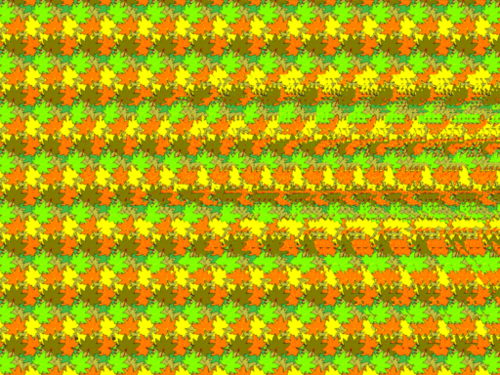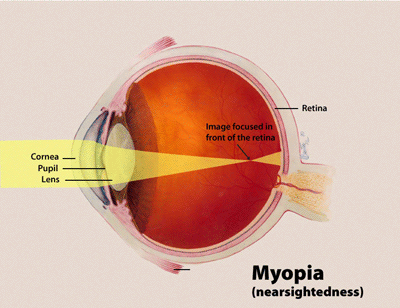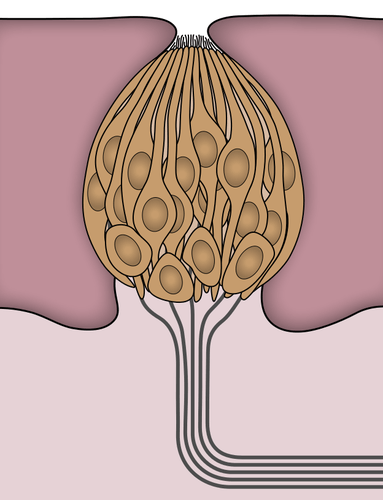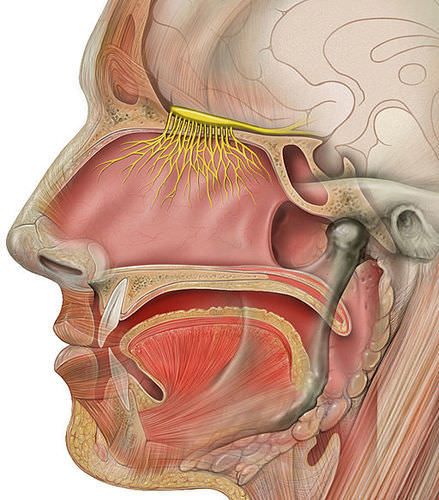10.7 人感应
章节大纲
-
Seeing Is Believing
::所见于相信At first glance, this figure appears to be a pattern of colored leaves, but hidden within it is the three-dimensional shape of an ant. Can you see it among the leaves? This figure is an example of a stereogram, which is a two-dimensional picture that, when viewed correctly, reveals a three-dimensional object. If you can’t see the hidden image, it doesn’t mean that there is anything wrong with your . It’s all in how your brain interprets what your eyes are sensing. The eyes are special sensory organs , and is one of our special senses.
::乍一看,这个图似乎是有色叶的图案,但隐藏在图中的是蚂蚁的三维形状。你能在叶子中看到这个图案吗?这个图案是一个立体图象的例子,这是一个二维图象,当正确观察时,它揭示出一个三维对象。如果你看不到隐藏的图象,那并不意味着你的图案有任何问题。这完全在于你的大脑如何解释你的眼睛是感知的。眼睛是特殊的感官器官,也是我们的一种特别感知力。Special and General Senses
::特别和一般感知The has two basic types of senses, called special senses and general senses. Special senses have specialized sense organs that gather sensory information and change it into . Special senses include vision (for which the eyes are the specialized sense organs), hearing (ears), balance (ears), taste (tongue), and smell (nasal passages). General senses, in contrast, are all associated with the sense of touch. They lack special sense organs. Instead, sensory information about touch is gathered by the skin and other body tissues , all of which have important functions besides gathering sense information. Whether the senses are special or general, however, they all depend on called sensory receptors .
::特殊感官有两种基本感官类型,称为特殊感官和一般感官。特殊感官有专门的感官器官,收集感官信息并将其转换为 。特殊感官包括视觉(眼睛是专门的感官器官 ) 、 听觉(耳 ) 、 平衡(耳 ) 、 口感(舌头 ) 、 嗅觉(鼻孔 ) 。 相比之下,一般感官都与触感感有关,它们缺乏特殊感官器官。相反,感官感官关于触感官的信息是由皮肤和其他身体组织收集的,除了收集感官信息之外,这些都具有重要的功能。但是,这些感官是特殊还是一般的,它们都依赖于所谓的感官受体。Sensory Receptors
::感感接收器A sensory receptor is a specialized nerve cell that responds to a stimulus in the internal or external environment by generating a nerve impulse. The nerve impulse then travels along the sensory (afferent) nerve to the for processing and to form a response.
::感官受体是一种专门的神经细胞,通过产生神经冲动来应对内外部环境中的刺激。 神经冲动随后沿着感官(后)神经流向处理和形成反应。There are several different types of sensory receptors that respond to different kinds of stimuli:
::有几种不同类型的感官受体对不同类型的刺激作出反应:-
Mechanoreceptors
respond to mechanical forces, such as pressure, roughness, vibration, and stretching. Most mechanoreceptors are found in the skin and are needed for the sense of touch. Mechanoreceptors are also found in the inner ear, where they are needed for the senses of
.
::机械机体对压力、粗糙、振动和伸展等机械力作出反应。 大部分机械机体在皮肤中被发现,需要触摸感。 机械机体也在内耳中找到,因为内耳需要机械机体来感知 。 -
Thermoreceptors
respond to variations in temperature. They are found mostly in the skin and detect temperatures that are above or below body temperature.
::温度受体对温度变化作出反应,主要见于皮肤,检测温度高于或低于体温。 -
Nociceptors
respond to potentially damaging stimuli, which are generally perceived as pain. They are found in internal organs, as well as on the surface of the body. Different nociceptors are activated depending on the particular stimulus.
S
ome detect damaging heat or cold, others detect excessive pressure, and still others detect painful chemicals (such as very hot spices in food).
::鼻孔对具有潜在破坏性的刺激反应,通常被认为是疼痛,它们存在于内脏器官和身体表面,不同的鼻孔依特定刺激因素而起作用。有些检测到有破坏性的热或冷,另一些检测到过度压力,还有一些检测到痛苦的化学物质(如食品中非常热的香料 ) 。 但有的检测到有破坏性的热或冷,有的检测到过度压力,还有的检测到痛苦的化学物质(如食品中非常热的香料 ) 。 -
Photoreceptors
detect and respond to light. Most photoreceptors are found in the eyes and are needed for the sense of vision.
::光受体检测和对光作出反应,大多数光受体在眼睛中发现,需要视觉感应。 -
Chemoreceptors
respond to certain chemicals. They are found mainly in taste buds on the tongue — where they are needed for the sense of taste — and in nasal passages, where they are needed for the sense of smell.
::乳房受体对某些化学物质作出反应,主要见于舌头的味蕾——需要它们来达到品味感——和鼻孔,需要它们来达到嗅觉感。
Touch
::触摸Touch is the ability to sense pressure, vibration, temperature, pain, and other tactile stimuli. These types of stimuli are detected by mechanoreceptors, thermoreceptors, and nociceptors all over the body, most noticeably in the skin. These receptors are especially concentrated on the tongue, lips, face, palms of the hands, and soles of the feet. Various types of tactile receptors in the skin are shown in the diagram .
::触摸是感应压力、振动、温度、疼痛和其他触觉刺激力的能力。这些类型的刺激力通过机械机能受体、热受体和体内的无受体检测到,最明显的是皮肤。这些受体特别集中在舌头、嘴唇、脸、手掌和脚底。图中显示了皮肤中各种类型的触觉受体。Tactile receptors in the skin include free nerve endings, Merkel cells, Meissner’s corpuscles, Pacinian corpuscles, root hair plexuses, and Ruffini corpuscles. Each type of sensory receptor responds to a different kind of tactile stimulus. For example, free nerve endings generally respond to pain and temperature variations, whereas Merkel cells are associated with the sense of light touch and the discrimination of shapes and textures.
::皮肤中的触觉受体包括自由神经末端、默克尔细胞、梅斯纳细胞、皮囊、帕西尼亚细胞、根毛双毛和鲁菲尼细胞。 每一种感官受体都响应不同种类的触觉刺激。 比如,自由神经末端一般会因疼痛和温度变化而反应,而默克尔细胞则与光触感和形状和纹理的区别相关。Vision
::愿景愿景愿景愿景Vision (or sight) is the ability to sense light and see. The eye is the special sensory organ that collects and focuses light and forms images. T he eye, however, is not sufficient for us to see. The brain also plays a necessary role in vision.
::视觉(或视觉)是感知光和视觉的能力。眼睛是收集和聚焦光和形状图像的特殊感官器官。但眼睛不足以让我们看到。大脑在视觉中也发挥着必要的作用。How the Eye Works
::眼眼如何运作The figure shows the anatomy of the human eye in cross-section. The eye gathers and focuses light to form an image, and then changes the image to nerve impulses that travel to the brain. The eye's functions in doing so are summarized in the following steps.
::该图显示了横截面的人类眼的解剖。 眼睛收集并聚焦光来形成图像, 然后将图像改变为神经脉冲, 从而进入大脑。 眼睛的功能将总结在以下步骤中 。-
Light passes first through the
cornea
, which is a clear outer layer that protects the eye and helps to focus the light by refracting (or bending) it.
::光首先穿过角膜,这是保护眼睛和帮助通过折射(或弯曲)使光聚焦的清晰外层。 -
Next, light enters the interior of the eye through an opening called the
pupil
. The size of this opening is controlled by the colored part of the eye (called the
iris
), which adjusts the size based on the brightness of the light. The iris causes the pupil to narrow in bright light and widen in dim light.
::接下来,光通过一个叫“学生”的开口进入眼睛的内部。开口的大小由眼睛的彩色部分(称为“虹膜”)控制,后者根据光的亮度调整大小。虹膜使学生在亮光下缩小,在暗光下扩大。 -
The light then passes through the
lens
, which refracts the light even more and focuses it on the
retina
at the back of the eye, as an inverted image.
::光线穿过镜头,使光线更加折射,将光线作为反向图像聚焦在眼睛后部的视网膜上。 -
The
retina
contains two types of photoreceptor cells: rods and cones.
Rods
, which are found mainly in all areas of the retina other than the very center, are particularly sensitive to low levels of light.
Cones
, which are found mainly in the center of the retina, are sensitive to light of different colors, and allow color vision. The rods and cones convert the light that strikes them to nerve impulses.
::视网膜包含两种光受体细胞:棒和锥体。 Rods主要在视网膜除中心外的所有地区发现,对低光度特别敏感。Cones主要在视网膜中心发现,对不同颜色的光很敏感,允许有色视线。棒和锥体将击中它们的光转换成神经脉冲。 -
The nerve impulses from the rods and cones travel to the
optic nerve
via the
optic disc
, which is a circular area at the back of the eye where the optic nerve connects to the retina.
::棒子和锥子的神经脉冲通过光碟传到视网膜的视神经,视网膜是眼睛后部的一个圆形区域,视神经与视网膜相连。
Trace the path of light through the eye as you read about in the five steps above.
::透过眼睛追踪光线的路径 正如你在上面的五步中读到的那样Role of the Brain in Vision
::脑展望的作用The optic nerves from both eyes meet and cross just below the bottom of the hypothalamus in the brain. The information from both eyes is sent to the visual cortex in the occipital lobe of the cerebrum , which is part of the cerebral cortex. The visual cortex is the largest system in the human brain, and is responsible for processing visual images. It interprets messages from both eyes and “tells” us what we are seeing.
::双眼的光学神经在大脑的脑下部与脑下部相交和交叉。 双眼的信息被发送到大脑皮层的一部分大脑皮层的皮层叶上的视觉皮层。 视觉皮层是人类大脑中最大的系统,负责处理视觉图像。 它解释来自双眼的信息和我们所看到的“ 洞穴 ” 。Vision Problems
::视觉问题Vision problems are very common. Two of the most common are myopia and hyperopia, and they often start in childhood or adolescence . Another common problem, called presbyopia, occurs in most people, beginning in middle adulthood . In all three conditions, the eyes fail to focus images correctly on the retina, resulting in blurred vision.
::视力问题非常常见。 两种最常见的问题是近视和高视率,它们通常始于童年或青春期,另一个常见问题,即所谓的先天性问题,发生在大多数人中,开始于成年期。 在这三个条件下,眼睛无法正确聚焦视网膜,导致视力模糊。Myopia
::近视Myopia (or nearsightedness) occurs when the light that comes into the eye does not directly focus on the retina, but in front of it, as shown in the diagram . As a result, distant objects may appear out of focus, but the focus of close objects is not affected. Myopia may occur because the eyeball is elongated from front to back, or because the cornea is too curved. Myopia can be corrected with the use of corrective lenses, either eyeglasses or contact lenses. Myopia can also be corrected by refractive surgery performed with a laser.
::当进入眼睛的光不直接聚焦视网膜时,即出现近视(或近视)时,眼睛的光线不是直接聚焦于视网膜,而是如图所示,在视网膜前面出现。结果,遥远的物体可能出现在视线之外,但近距离物体的焦点没有受到影响。可能出现近视,因为眼球从前向后延伸,或者角膜太弯曲。通过使用矫正镜(眼镜或接触镜)可以纠正近视。使用激光进行反射手术也可以纠正近视。Hyperopia
::超opiaHyperopia (or farsightedness) happens when the light coming into the eye does not directly focus on the retina but behind it, as shown in the diagram . This causes close objects to appear out of focus, but does not affect the focus of distant objects. Hyperopia may occur because the eyeball is too short from front to back, or because the lens is not curved enough. Hyperopia can be corrected through the use of corrective lenses or laser surgery.
::Hyperopia (或远视) 出现时, 眼中的光线不是直接聚焦于视网膜而是其背后, 如图所示 。 这导致近距离物体出现于焦点之外, 但不会影响远距离物体的焦点 。 超opia 可能发生, 因为眼球从正面到背后太短, 或镜头不够弯曲 。 Hyperopia 可以通过使用矫正镜片或激光外科来纠正 。Presbyopia
::预胎Presbyopia is a vision problem associated with aging, in which the eye gradually loses its ability to focus on close objects. The precise origin of presbyopia is not known for certain, but evidence suggests that the lens may become less elastic with age, causing the that control the lens to lose power as people grow older. The first signs of presbyopia – eyestrain, difficulty seeing in dim light, problems focusing on small objects and fine print – are usually first noticed between the ages of 40 and 50. Most older people with this problem use corrective lenses to focus on close objects, because surgical procedures to correct presbyopia have not been as successful as those for myopia and hyperopia.
::远视是一种与衰老相关的视力问题,眼神逐渐丧失了关注近距离物体的能力。 远视的精确来源并不明确,但有证据表明,透镜随着年龄变小可能会失去弹性,从而导致控制透镜随着人们的老化而失去权力。 前视镜的最初迹象 — — 眼力减退、在暗光中难以看见、关注小物体和精美印刷的问题 — — 通常在40至50岁之间首先被注意到。 大多数有这一问题的老年人使用矫正透镜聚焦近距离物体,因为纠正远视镜的手术程序没有近视和高视成功。Hearing
::听取听取听取听取听取听取听取听取听取听取听取听取听取听取听取听取Hearing is the ability to sense sound waves, and the ear is the organ that senses sound. Sound waves enter the ear through the ear canal and travel to the eardrum (see the diagram of the ear ). The sound waves strike the eardrum, and make it vibrate. The vibrations then travel through the three tiny (hammer, anvil, and stirrup) of the middle ear, which amplify the vibrations. From the middle ear, the vibrations pass to the cochlea in the inner ear. The cochlea is a coiled tube filled with liquid. The liquid moves in response to the vibrations, causing tiny hair cells (which are mechanoreceptors) lining the cochlea to bend. In response, the hair cells send nerve impulses to the auditory nerve , which carries the impulses to the brain. The brain interprets the impulses and “tells” us what we are hearing.
::听觉是感知声波的能力, 耳是感知声音的器官。 听觉波通过耳渠道进入耳耳, 进入耳膜( 参见耳朵图 ) 。 听觉波击中耳膜, 使其振动。 震动会穿过中耳的三个小耳( 锤子、 子和子), 放大震动。 从中耳, 震动会传到内耳的科赫莱亚。 科赫莱亚 是一个充满液体的凝结管。 液体会对震动作出反应, 导致细小的发细胞( 机械感官) 嵌入耳洞以弯曲。 作为回应, 发细胞会把神经冲动传到脑部的听觉神经。 大脑会解读脉冲和“ 提示 ” 我们所听到的东西。Most of the structures of the ear are involved in hearing. Only the semicircular canals are not involved in hearing. Instead, they sense head position, which is used to monitor balance.
::耳部大部分结构都与听力有关,只有半循环运河与听力无关,相反,它们能感觉到头部位置,用来监测平衡。Balance
::余额余额余额余额余额The ears are also responsible for the sense of balance. Balance is the ability to sense and maintain an appropriate body position. The semicircular canals inside the ear (see the figure ) contain fluid that moves when the head changes position. Tiny hairs lining the semicircular canals sense movement of the fluid. In response, they send nerve impulses to the vestibular nerve , which carries the impulses to the brain. The brain interprets the impulses and sends messages to the , which triggers contractions of as needed to maintain balance.
::耳朵也是平衡感的原因。 平衡是感知和保持适当的身体姿势的能力。 耳内半循环渠道( 见图 ) 含有当头部改变位置时移动的流体。 细毛衬衬里半循环渠道能感应流体的移动。 作为回应, 它们向将脉冲带入大脑的脊髓神经发送神经脉冲。 大脑会解释脉冲, 向大脑发送信息, 从而引发必要的收缩以保持平衡。Taste and Smell
::尝尝和闻闻are both abilities to sense chemicals, so both taste and olfactory (odor) receptors are chemoreceptors. Both types of chemoreceptors send nerve impulses to the brain along sensory nerves , and the brain “tells” us what we are tasting or smelling.
::这两种体系都是感知化学物质的能力,因此口味和嗅觉(气味)受体都是电荷受体。 这两种体系都向大脑发出感官神经神经神经的神经冲动,而大脑“触觉”则向我们发出我们正在尝试或闻闻的东西。Taste receptors are found in tiny bumps on the tongue called taste buds. You can see a diagram of a taste receptor cell and related structures in the drawing . Taste receptor cells make contact with chemicals in food through tiny openings called taste pores . When certain chemicals bind with taste receptor cells, it generates nerve impulses that travel through afferent nerves to the CNS. There are separate taste receptors for sweet, salty, sour, bitter, and meaty tastes. The meaty — or savory — taste is called umami .
::味道受体在舌头上的小肿块中找到,叫作味蕾。你可以在图中看到一个品味受体细胞和有关结构的图表。味道受体细胞通过称为味孔的小开口接触食物中的化学物质。当某些化学物质与品味受体细胞结合时,会产生神经脉冲,通过发酵神经进入CNS。甜、咸、酸、苦和肉类的口味有不同的味感。肉类或肉类的口味被称为 " 乳蜜 " 。Taste receptor cells are located in taste buds on the tongue. Basal cells are not involved in tasting, but differentiate into taste receptor cells. Taste receptor cells are replaced about every nine to ten days.
::舌头上的受试细胞位于舌头的味蕾中,巴斯尔细胞不参与品尝,而是区分为受试细胞,大约每隔九至十天更换一次受试细胞。The yellow structures inside this drawing of the nasal passages are an olfactory nerve with many nerve endings. The nerve endings sense chemicals in the air as it passes through the nasal cavities.
::这幅鼻腔通道图中的黄色结构是一种嗅觉神经,有许多神经末端。 神经末端在通过鼻腔时感知到空气中的化学物质。Feature: Human Biology in the News
::特著:《新闻》中的人类生物学The most common cause of blindness in the Western hemisphere is age-related macular degeneration (AMD). Approximately 15 million people in the United States have this type of blindness, and 30 million people are affected worldwide. At present, there is no cure for AMD. The disease occurs with the death of a layer of cells called retinal pigment epithelium, which normally provides nutrients and other support to the macula of the eye. The macula is an oval-shaped pigmented area near the center of the retina that is specialized for high visual acuity and has the retina’s greatest concentration of cones. When the epithelial cells die and the macula is no longer supported or nourished, the macula also starts to die. Patients experience a black spot in the center of their vision, and as the disease progresses, the black spot grows outward. Patients eventually lose the ability to read and even to recognize familiar faces before developing total blindness.
::西半球最常见的失明原因是与年龄有关的雄性畸形(AMD ) 。 美国约有1500万人患有这种失明,全世界有3000万人受到影响。 目前,对AMD没有治疗方法。 这种疾病发生在被称为视网膜色素上皮的细胞层死亡时,该细胞层通常为眼睛的肌肉提供养分和其他支持。 Maccula是一个位于视网膜中心附近的奥瓦尔形色素区,专门用于高视觉敏锐度,视网膜中最集中的锥形。 当上皮细胞死亡,而大毛细胞不再支持或养活,大毛细胞也开始死亡。 病人在视力中心出现黑点,随着疾病的发展,黑点会向外蔓延。 病人最终会失去阅读能力,甚至会在完全失明之前识别熟悉面的能力。In 2016, a landmark surgery was performed as a trial on a patient with severe AMD. In the first ever operation of its kind, Dr. Pete Coffey of the University of London implanted a tiny patch of cells behind the retina in each of the patient’s eyes. The cells were retinal pigmented epithelial cells that had been grown in a lab from cells, which are undifferentiated cells that can develop into other cell types. Within six months of the operation, the new cells were still surviving, and the doctor was hopeful that the patient’s vision loss would stop and even be reversed. At that point, several other operations had already been planned to test the new procedure. If these cases are a success, Dr. Coffey predicts that the surgery will become as routine as cataract surgery, and that it will prevent millions of patients from losing their vision.
::2016年,对一位患有严重AMD的病人进行了具有里程碑意义的手术。 伦敦大学的皮特·科菲博士在第一次此类手术中,在病人眼睛的视网膜后面植入了一小块细胞。 这些细胞都是在实验室里从细胞中培养出来的视网膜色素外皮细胞,这些细胞是能够发展成其他细胞类型的无差异细胞。 在手术的六个月内,新细胞仍然存活下来,医生希望病人的视力损失会停止甚至逆转。 当时,其他几项手术已经计划测试新手术。 如果这些病例是成功的,科菲博士预测手术会像白内障手术一样常规化,并且会防止数百万病人失去视力。Summary
::摘要-
The human body has two major types of senses: special senses and general senses. Special senses have specialized sense organs and include vision (eyes), hearing (ears), balance (ears), taste (tongue), and smell (nasal passages). General senses are all associated with touch and lack special sense organs. Touch receptors are found throughout the body, but particularly in the skin.
::人体有两种主要的感官类型:特殊感官和一般感官。特殊感官有专门的感官器官,包括视力(眼睛)、听力(耳)、平衡(耳)、口感(舌头)和嗅觉(鼻孔 ) 。一般感官都与触摸有关,缺乏特殊感官器官。触感受体在整个身体,特别是皮肤中都有。 -
All senses depend on sensory receptor cells to detect sensory stimuli and transform them into nerve impulses. Types of sensory receptors include mechanoreceptors (mechanical forces), thermoreceptors (temperature), nociceptors (pain), photoreceptors (light), and chemoreceptors (chemicals).
::所有感官都依赖感官受体细胞来检测感官刺激,并将其转化为神经脉冲。 感官受体的类型包括机械感官(机械力 ) 、 热受体( 温度 ) 、 鼻受体( 帕因 ) 、 光受体( 灯光 ) 和 电机受体( 化学 ) 。 -
Touch
is
the ability to sense pressure, vibration, temperature, pain, and other tactile stimuli. The skin includes several different types of touch receptor cells.
::触摸是感应压力、振动、温度、疼痛和其他触觉刺激的能力。皮肤包括几种不同类型的触摸受体细胞。 -
Vision is the ability to sense light and see. The eye is the special sensory organ that collects and focuses light, forms images, and changes them to nerve impulses. Optic nerves send information from the eyes to the brain, which processes the visual information and “tells” us what we are seeing.
::视觉是感知光和视觉的能力。 眼睛是特殊的感官器官,收集和聚焦光,形成图像,将其改变为神经冲动。 光神经将信息从眼睛传递到大脑,它处理视觉信息和我们所看到的“言语 ” 。 -
Common vision problems include myopia (nearsightedness), hyperopia (farsightedness), and presbyopia (age-related decline in close vision). Vision problems can be corrected with lenses (eyeglasses or contacts) or — in many cases — with laser surgery.
::常见的视力问题包括近视(近视)、高视(远视)和远视(近视与年龄有关的衰落),可以通过透镜(眼镜或接触器)或在许多情况下通过激光手术纠正视力问题。 -
Hearing is the ability to sense sound waves, and the ear is the organ that senses sound. It changes sound waves to vibrations that trigger nerve impulses, which travel to the brain through the auditory nerve. The brain processes the information and “tells” us what we are hearing.
::听力是感知声波的能力,耳是感知声音的器官。 它将声波改变为触发神经脉冲的震动,神经脉冲通过听力神经进入大脑。 大脑处理我们听到的信息和“声音 ” 。 -
The ear is also the organ responsible for the sense of balance, which is the ability to sense and maintain an appropriate body position. The ears send impulses about head position to the brain, which sends messages to skeletal muscles via the peripheral nervous system. The muscles respond by contracting to maintain balance.
::耳朵也是负责平衡感的器官,即感知和保持适当身体姿势的能力; 耳朵向大脑发出头部姿势的冲动,大脑通过边缘神经系统向骨骼肌肉发送信息; 肌肉通过保持平衡而反应。 -
Taste and smell are both abilities to sense chemicals. Taste receptors in taste buds on the tongue sense chemicals in food,
while
olfactory receptors in the nasal passages sense chemicals in the air.
S
ense of smell contributes significantly to sense of taste.
::口味和嗅觉都是感知化学物质的能力。 口语感化学物质在食物中的尝受体,口腔感化学物质在食物中的尝受体,鼻孔的嗅觉受体在空气中感知化学物质。 嗅觉感知极大地促进了口味感。
Review
::回顾1. Compare and contrast special senses and general senses.
::1. 比较和对比特殊感知和一般感知。2. What are sensory receptors?
::2. 什么是感官受体?3. List five types of sensory receptors and the type of stimulus each detects.
::3. 列出五类感官受体和每种刺激检测的种类。4. Describe the range of tactile stimuli detected in the sense of touch.
::4. 描述触摸感中检测到的触觉刺激范围。5. Explain how the eye collects and focuses light to form an image, and how it converts it to nerve impulses.
::5. 解释眼睛如何收集和集中光来形成图像,以及如何将其转化为神经冲动。6. Identify two common vision problems, along with their causes and their effects on vision.
::6. 查明两个共同的远景问题及其原因及其对远景的影响。7. Explain how structures of the ear collect and amplify sound waves and transform them to nerve impulses.
::7. 解释耳朵结构如何收集和放大声波,如何将其转化为神经冲动。8. What role does the ear play in balance? Which structures of the ear are involved in balance?
::8. 耳朵在平衡方面起什么作用?耳朵的哪些结构在平衡方面起作用?9. Describe two ways that the body senses chemicals. What are the special sense organs involved in these senses?
::9. 描述身体感应化学物的两种方式:这种感应感应的特感器官是什么?10. Explain why your skin can detect different types of stimuli, such as pressure and temperature.
::10. 解释为何皮肤能检测到压力和温度等不同类型的刺激因素。11. Is sensory information sent to the central nervous system via efferent or afferent nerves?
::11. 感官信息是经由中枢神经系统发送的还是通过中枢神经系统发送的?12. Identify a mechanoreceptor used in two different human senses. Describe the type of mechanical stimuli that each detects.
::12. 查明两种不同人类意义上使用的机械机体受体,说明每种探测的机械刺激类型。13. If a person is blind, but their retina is functioning properly, where do you think the damage might be? Explain your answer.
::13. 如果一个人失明,但视网膜正常运转,你认为损害可能在哪里?解释你的答复。14. When you see colors, what receptor cells are activated? Where are these receptors located? What lobe of the brain is primarily used to process visual information?
::14. 当你看到颜色时,什么受体细胞被激活?这些受体的位置在哪里?大脑的哪个叶子主要用于处理视觉信息?15. The auditory nerve carries _______________.
::15. 听觉神经携带。a. smell information
::a. 嗅闻信息b. taste information
::b. 品尝资料c. balance information
::c. 平衡信息d. sound information
::d. 可靠信息Explore More
::探索更多Some people “see” sounds, “hear” colors, or “taste” words. This rare ability is called synesthesia, and it is thought to be caused by cross-wiring of the senses in the brain. To learn more about this intriguing phenomenon, watch this fascinating TED animation:
::有些人“看到”声音、“听”颜色或“喜”字。这种稀有的能力被称为合成麻醉,据认为是大脑感官交叉连接造成的。为了更多地了解这个有趣的现象,请看这个迷人的TED动画片:Many people experience the dizzying effects of vertigo at some point in their lives. Learn more here:
::许多人在人生的某个阶段都经历着眩晕的晕眩效应。 -
Mechanoreceptors
respond to mechanical forces, such as pressure, roughness, vibration, and stretching. Most mechanoreceptors are found in the skin and are needed for the sense of touch. Mechanoreceptors are also found in the inner ear, where they are needed for the senses of
.







